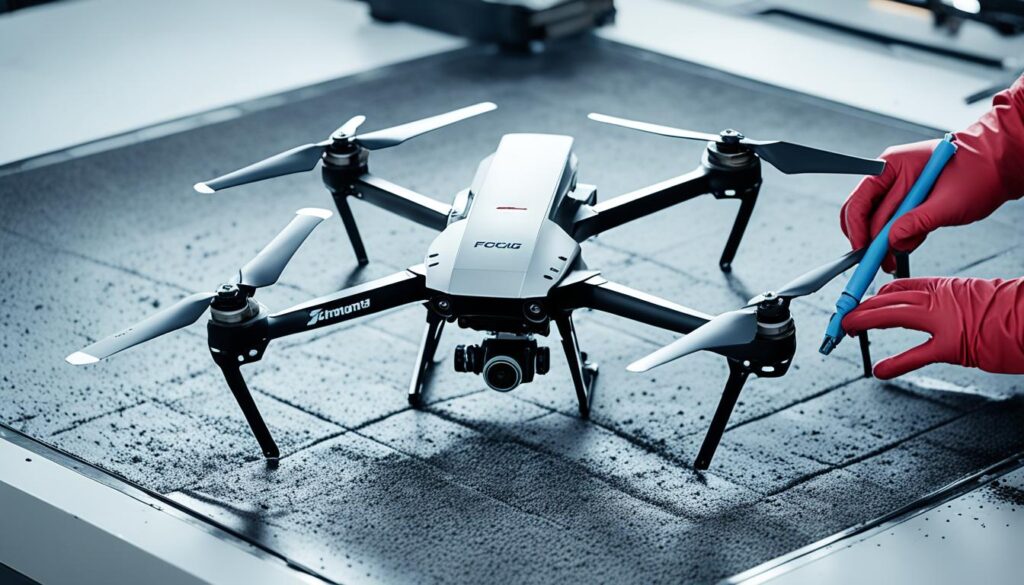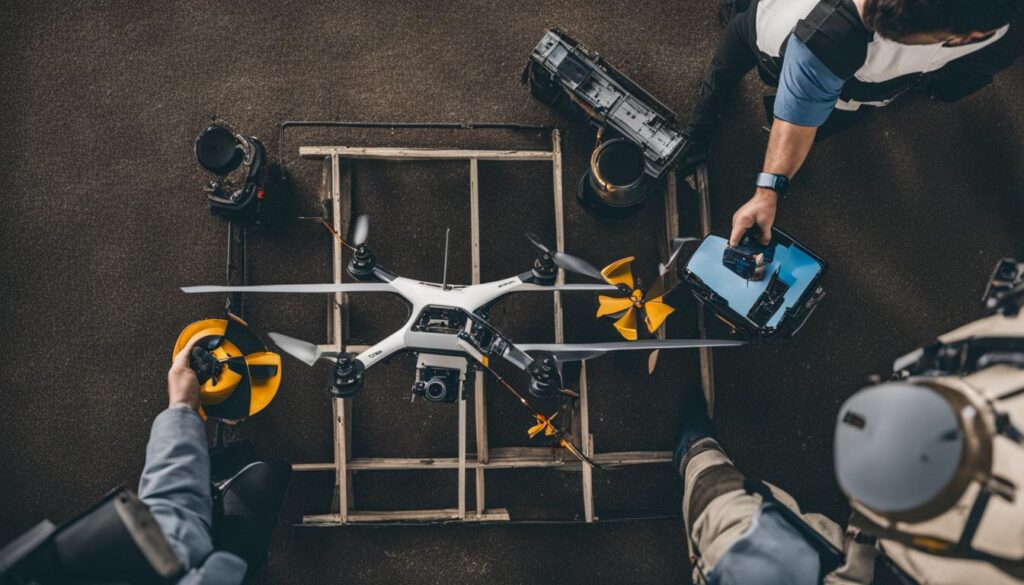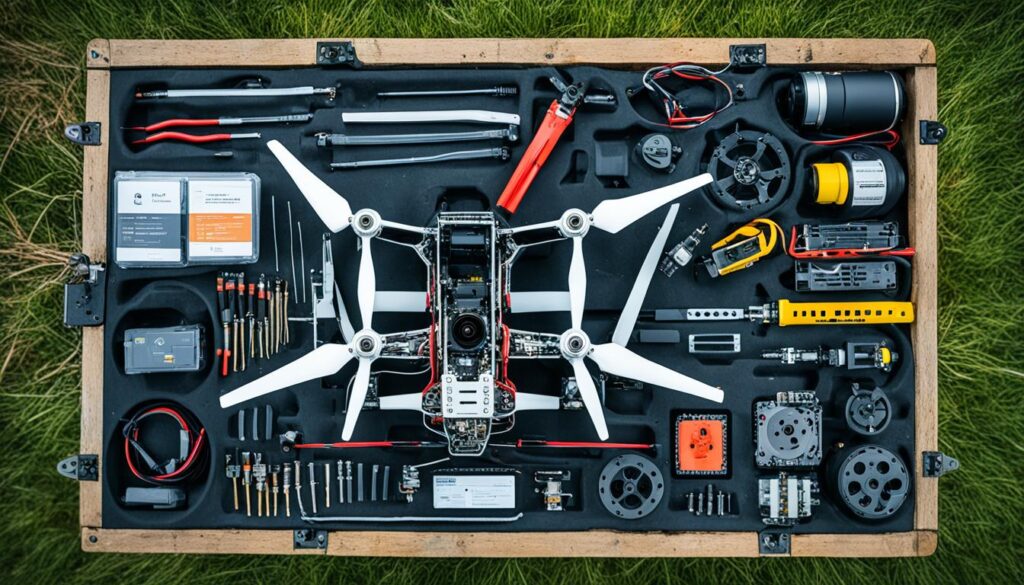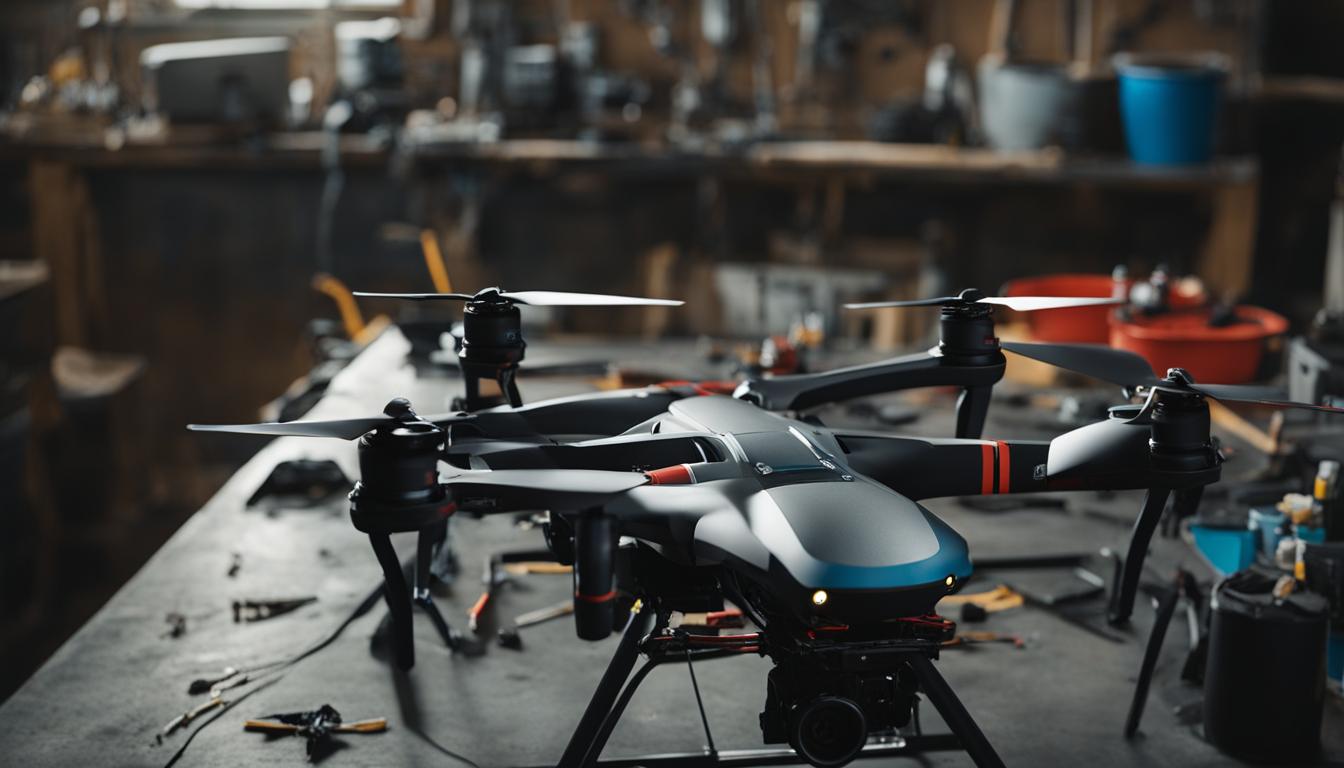Drones have become indispensable assets in various industries, and their value is only as reliable as the condition they’re kept in. Implementing a Basic Drone Maintenance Checklist is the cornerstone of preserving your Unmanned Aerial Vehicle (UAV) systems, keeping them primed for the skies whether they fly solo or in fleets. Meticulous adherence to a drone upkeep schedule not only maximizes operational efficiency but also extends the lifespan of your technological investment. By incorporating essential drone maintenance tasks into your routine, you secure a consistent performance level and safety for your drone operations.
Proper drone care is not a one-time event but an ongoing commitment. As your UAV endures the rigors of frequent flights, the need for regular inspections and servicing increases. By establishing and following a methodical maintenance strategy, you ensure that each flight is conducted with the utmost confidence in your drone’s capabilities and safety. Let’s embark on this critical journey of preventative maintenance to ascertain your UAV’s longevity and fidelity.
Understanding the Importance of Drone Maintenance
To ensure that drones operate effectively and last long, a solid drone care routine is paramount, much like the recommended maintenance for vehicles. This routine is not only about responding to issues as they arise but also about preemptively handling potential problems before they become significant. Drone maintenance best practices involve consistent check-ups that can save operators from costly repairs or replacements down the line.
Regular drone maintenance is about keeping your drone in top condition, which requires an understanding of the various elements that need attention. From software updates to hardware inspections, maintaining a drone is critical for its longevity and performance. By following a structured checklist and performing maintenance either after every ten flights or bi-weekly, operators can be confident that their equipment remains safe and reliable.

Adapting the drone maintenance schedule according to the frequency of use ensures that each drone receives care that’s appropriate for its workload. The goal is to integrate maintenance into the regular usage of the drone, thereby reducing the likelihood of malfunction or total failure during critical operations.
- Inspection of propellers and motors to prevent in-flight issues.
- Checking battery connections and power levels to ensure optimal performance.
- Attending to software updates for the latest features and security.
- Cleaning and adjusting sensors for accurate data collection.
In conclusion, a well-maintained drone is a dependable asset in any operator’s toolkit. With the right care routine and awareness of maintenance best practices, drone enthusiasts and professionals alike can enjoy the benefits of their UAVs without unexpected disruptions.
Pre-Flight Preparation and Check
Ensuring your drone is airworthy before each flight is not just good practice—it’s essential for the safety and longevity of your UAV. A comprehensive pre-flight check that includes pilot and drone identification and a meticulous cleaning of the chassis can make all the difference in your drone’s performance.
Recording Drone Identification and Details
Before the propellers even start whirring, ensuring all pertinent information is up-to-date and accessible is a key part of how to maintain a drone. This includes recording the drone’s model, serial number, and any flight identification details. These records are crucial not only for the sake of organization but also for regulatory compliance and potential troubleshooting.
Cleaning the Chassis
Drone care tips often stress the importance of a clean chassis. A clean chassis ensures that no dirt or debris will interfere with the structural inspection. Remember to disconnect battery packs and power down the drone before rolling up your sleeves to tackle the cleaning process. Using the right tools here is critical—not just to get the job done but to ensure you aren’t causing inadvertent damage.
The following table outlines the designated equipment recommended for cleaning your drone and maintaining its pristine condition:
| Equipment | Use |
|---|---|
| Anti-Static Cloth | For wiping down and dusting off the surface without scratching. |
| Small Cleaning Brush | To remove dirt from grooves and hard-to-reach places. |
| Compressed Air Canister | For blowing away loose debris without physical contact. |
| Anti-Static Wristband | Provides safety for the user and protects the drone from static discharge during cleaning. |
| Isopropyl Alcohol | To clean and sanitize without leaving residue, particularly on electronic components. |
Use the designated equipment to remove dirt buildup and tougher stains carefully, always focusing on being gentle around sensitive electronic components. Regular chassis cleaning not only facilitates a more thorough inspection but also preserves the integrity of the drone’s body and electronic systems.

Conducting a Thorough Structural Inspection
Ensuring the reliability and safety of your drone starts with a comprehensive structural inspection. A key part of any drone maintenance guide, this step involves meticulously examining the aircraft’s body to identify any potential issues that may compromise its performance or structural integrity.

Inspecting the Chassis for Cracks
One of the fundamental drone maintenance tasks is to visually inspect the chassis for any signs of wear, including small cracks that can escalate into significant problems if left unattended. Detection and documentation of such imperfections are essential to address them before they lead to system failure.
Checking for Loose Screws and Bolts
Inspecting for loose screws forms a critical part of maintaining your drone’s operational readiness. It ensures all components are securely in place. During both routine maintenance and repairs, checking screw and bolt tightness is vital for maintaining joint integrity and preventing damage. Reaffirming the security of these fastenings, while avoiding over-tightening, preserves the drone’s structural integrity without risking additional stress to the parts.
Ensuring Propeller and Motor Integrity
Regular drone maintenance is essential to safeguard flight performance and prolong the lifespan of your equipment. An often-overlooked aspect of this process is the frequent inspection and cleaning of propeller blades and motor chambers. These components are critical to the proper functioning of your drone, and keeping them in prime condition is a staple in how to maintain a drone.
Evaluating Propellers for Damage
Propellers, despite their robust appearance, are susceptible to damage which could compromise your drone’s stability in flight. Essential drone maintenance tasks include a careful examination of each blade for signs of wear, cracks, or bending. After any incident, ensuring that the propellers are intact is imperative before proceeding with the next flight.
Assessing Motors for Debris and Obstructions
Ensuring the motor chamber is clear of debris like grit, dirt, or organic matter is a crucial part of maintenance. A blocked motor can lead to overheating or failure mid-flight, both of which are hazards that can be averted with regular checks. Cleaning out foreign matter typically requires you to remove the propellers and hunt for obstructions that could hinder motor efficiency. In some cases, further disassembly may be necessary for a comprehensive clean. Always refer to your drone model-specific instructions for proper handling and reassembly to prevent damage to the intricate motor assemblies.

To streamline your drone care routine, the following table provides a quick reference checklist for maintaining propeller and motor integrity:
| Component | Inspection Task | Cleaning Instructions | Maintenance Frequency |
|---|---|---|---|
| Propellers | Check for cracks, warping, or loose fittings | Wipe with a soft, dry cloth | Before each flight and after any incidents |
| Motor Chamber | Inspect for debris and obstructions | Remove propellers, clean with compressed air | Every 10 flights or as needed |
By adhering to these essential drone maintenance tasks, pilots can ensure their drones are not only airworthy but also optimized for the crispest maneuvering and longest possible operation life. A clean and well-maintained drone is a reliable and high-performing drone.
Basic Drone Maintenance Checklist
Maintaining your drone’s performance and ensuring its longevity requires adherence to drone maintenance best practices. A methodical approach to essential drone maintenance tasks can prevent mechanical and technical failures that may compromise safety and efficiency. Below is an invaluable checklist that should become part of your routine drone upkeep schedule.
- Inspect the chassis for any visible cracks or damage.
- Ensure all screws and bolts are tightened appropriately.
- Check propellers for damage such as nicks, chips, or bends.
- Assess motors for debris and remove any obstructions.
- Verify antennae are fitted properly and are in good condition.
- Ensure the camera lens is clean for optimal recording.
- Inspect the landing gear for signs of wear or damage.
- Update the drone’s firmware to the latest version.
- Inspect battery packs and chargers for any signs of damage.
- Update control station software as necessary.
Consistently following this checklist ensures your drone remains in excellent working order and helps to spot potential issues before they lead to down-time or costly repairs.
| Maintenance Task | Description | Frequency |
|---|---|---|
| Chassis Inspection | Checking for cracks or structural issues | After every flight session |
| Fasteners Check | Ensuring screws and bolts are tight | Weekly |
| Propeller Assessment | Inspecting for damage or wear | Before every flight |
| Motor Cleaning | Removing debris from around motors | Monthly |
| Antennae Check | Ensuring secure fitting and good condition | As needed |
| Camera Lens Cleaning | Maintaining clarity for recordings | Before every flight |
Embracing this checklist is not just about fixing what’s already broken, but about proactive measures to ensure your drone’s optimal performance during its lifecycle. With drone maintenance best practices, you protect your investment and gain peace of mind with every flight.
Assessing Electrical Components and Wiring
When it comes to drone maintenance guide principles, prioritizing the electrical systems that power your UAV is paramount. Not only does it ensure seamless flights, but it also extends the lifespan of the drone. Thorough drone care tips will undoubtedly include a careful inspection of wiring and solder points, as well as the critical electronics that govern your drone’s capabilities.
Checking the State of Wiring and Solder Points
The intricate electrical wiring of a drone is its lifeblood, so identifying any issues before they escalate is essential. Assessing the state of the wiring involves a meticulous examination for fraying, wear, and tear, or any kind of degradation that might compromise the drone’s performance. Similarly, solder points must be intact and stable, as they are the critical junctions for a drone’s circuitry. Any damage or loose connections here can lead to malfunction or even total power failure when in flight.
Verifying the Functionality of Electronics
Ensuring the functionality of your drone’s electronics is a fundamental step in any drone maintenance guide. This essentially encompasses checking the cleanliness of the drone’s camera lens—a clear view is crucial for those picture-perfect shots or accurate surveyance jobs. Similarly, the GPS and control station components must be undamaged and functioning correctly to ensure smooth navigation and control. Proper maintenance of the antennae is indispensable for maintaining connectivity, and this includes thorough inspections to verify they are undamaged and operating as expected.
The overarching aim of maintaining these components is to forestall any connectivity or control issues, which could spell disaster during flight operations. By adhering to the recommended care practices and utilizing the correct cleaning techniques and tools, you can guard against unexpected component failures and ensure your drone is always ready for takeoff.
Battery Care and Optimization
Keeping a drone in the air requires not just skill but meticulous drone battery maintenance attention. Like the heart of your aerial platform, the battery demands careful and regular care to ensure that every flight is smooth, and every landing, safe. An integral part of your drone care routine centers around these energy cells that power your flights.
Inspecting the Charger and Battery Packs
Industry experts cannot overemphasize the importance of conducting thorough inspections of battery chargers and packs. Users need to be vigilant for signs of wear, such as visible damage to the charger or signs of bulging and leakage in the battery packs. It’s crucial that these checks are made both before and after use to avoid in-flight failures and potential damage to your drone.
Managing Charge Levels and Firmware Updates
Keeping the battery’s charge near 50% when not in use is a golden rule for preservation. Monitoring voltage and ensuring the cleanliness of contact points are also key steps that should not be overlooked if one hopes to maintain battery health. Furthermore, firmware updates are not just beneficial; they are often critical for enhancing performance and expanding the lifespan of batteries. Always conduct these updates in line with the manufacturer guidelines to guarantee the best results.
Software and Hardware Updates
Maintaining the efficiency of your drone involves a commitment to regular software and hardware examinations. This critical aspect of essential drone maintenance tasks serves as a linchpin for reliable UAV operation. With rapidly advancing technology, staying abreast of updates is a non-negotiable part of your drone upkeep schedule.
Regular firmware updates facilitate seamless functioning, enhancing features, and addressing latent issues that could hinder performance. Hardware upgrades are just as paramount, with components such as propellers and antennae demanding timely assessments for wear and tear.
| Update Type | Purpose | Schedule |
|---|---|---|
| Firmware | Improves UAV features and addresses software issues. | As recommended by manufacturer or after significant changes to operating conditions. |
| Hardware | Ensures physical integrity and optimal performance. | Inspect after every 10 flights or monthly, and replace as needed. |
| Propellers | Checks for cracks, wear, and functionality. | Pre-flight and post-flight inspections, replace immediately if damaged. |
| Antennae | Guarantees strong connectivity and control. | Review during each maintenance check, replace if there’s visible damage or connectivity issues. |
| Electronic Speed Controllers (ESC) | Maintains proper motor speeds and drone stability. | Assess responsiveness and look for signs of electrical faults during routine maintenance. |
Committing to this regimented approach ensures your drone remains a steadfast tool in your aerial endeavors. Consider setting reminders or scheduling regular check-ins to never miss an important update, keeping your drone’s capabilities at their peak.
Conclusion
The meticulous attention to drone maintenance best practices is not merely about keeping a UAV serviceable; it’s about ensuring the seamless operation and reliability of your equipment over time. The key to achieving this lies in the consistent adherence to a Basic Drone Maintenance Checklist. By committing to this regimen, pilots are not just looking after the physical aspects of their drones but are also proactively mitigating risks that can lead to in-flight failures and costly repairs.
Through routine inspections that include checking structural integrity, propeller and motor assessments, and battery care, drone operators can substantially reduce the likelihood of malfunctions. Moreover, the dedicated practice of software and hardware updates forms the backbone of a sound maintenance guide, driving both the drone’s longevity and its adept performance. Keep in mind that these efforts do not solely preserve the drone’s operational capacity, but they also reinforce the safety protocols that are intrinsic to responsible UAV handling.
In summation, the preservation of your aerial asset—be it for recreational, commercial, or industrial purposes—is invariably tied to your commitment to proper cleaning, storage, and systematic upkeep routine. A drone well-maintained is an investment secure, a testament to the efficacy of a comprehensive drone maintenance guide. As such, it is critical for drone enthusiasts and professionals alike to internalize these core practices, ultimately safeguarding the functionality and flight safety of their drones.
FAQ
What items are included in the Basic Drone Maintenance Checklist?
The checklist includes checking for chassis cracks; ensuring screws, bolts, and wiring are secure; inspecting propellers and motors; assessing the condition of antennae, camera, and landing gear; updating firmware and control station software; inspecting battery packs and chargers; and performing regular software and hardware updates.
Why is regular drone maintenance important?
Regular maintenance ensures the longevity and optimal performance of your drone by identifying and resolving issues promptly. It prevents disruptions in operations, extends the life of the drone, and promotes flight safety.
How often should I perform maintenance checks on my drone?
Maintenance checks should be tailored to the frequency of drone usage. As a general rule, performing a routine inspection after every ten flights or bi-weekly is recommended, although this may vary depending on the intensity and conditions of use.
What should be done to prepare a drone for a maintenance check?
Preparation for a maintenance check includes recording drone identification and model details and thoroughly cleaning the chassis. You should use an air duster, microfiber cloth, and a little water, and ensure the drone is powered down and the battery packs are disconnected before cleaning.
How do I inspect the drone’s chassis and what am I looking for?
Inspect the chassis visually for any small cracks, damage, or deformities. It’s crucial to check the drone’s integrity to catch and address minor issues that could lead to significant problems in the future.
What should I check for when inspecting propellers and motors?
When inspecting propellers, look for cracks or looseness that could lead to mid-flight malfunctions. For motors, check for debris and obstructions that might impede their function. Make sure the motor chamber is clear and the propellers are removed during cleaning if necessary.
How do I assess the electrical components and wiring of my drone?
Assess electrical components by checking for any frayed wires, worn points, and loose connections. Verify the functionality of all electronic components, including the cleanliness of the camera lens and the condition of GPS and control station components.
What is the correct way to care for my drone’s battery and charger?
Inspect the charger for damage and the battery packs for bulging or leakage. Implement proper charging practices and store batteries at an optimal charge level—ideally around 50% for prolonged battery life. Regularly monitor voltage and maintain the cleanliness of contact points.
Why are software and hardware updates important for drones?
Software and hardware updates address known issues, enhance performance features, and often introduce new functionalities to your drone. Firmware updates, in particular, can improve stability and extend the capabilities of both the drone and the control system.

Leave a Reply